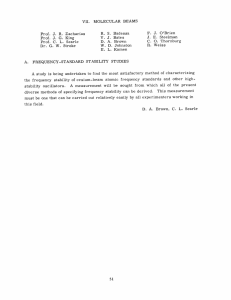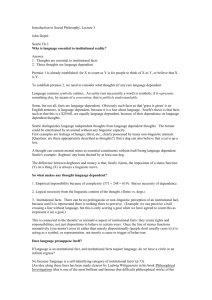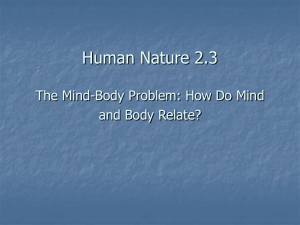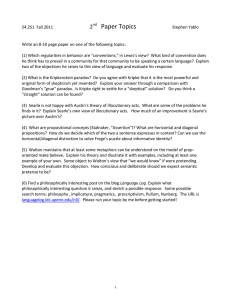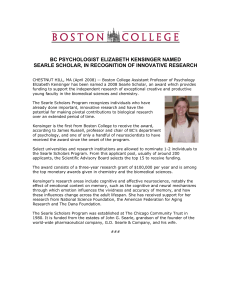Consciousness
advertisement
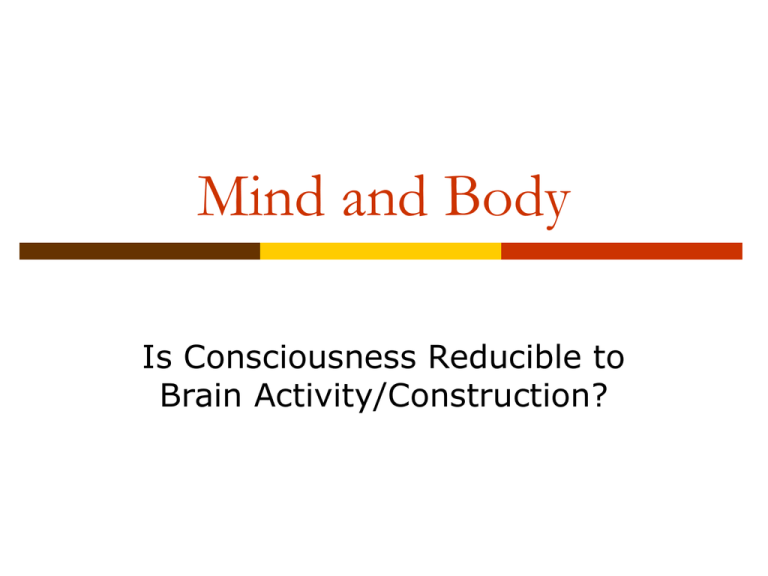
Mind and Body Is Consciousness Reducible to Brain Activity/Construction? What is “Reduction”? It’s always easier to start with examples: Visually and tactilely, a piece of bread is a squarish, compressible thing that is edible. Nutritionally, a piece of bread is a complex of carbohydrates, minerals, vitamins and so forth, arranged in a particular molecular structure. A “reduction” of bread occurs when we understand that bread just is the molecules that comprise its structure as a complex of carbohydrates, etc. What is “Reduction”? Another example (Searle’s): Tactilely, heat is an uncomfortable sensation we experience in the presence of some things. Physically, heat is a measure of the kinetic activity of molecules. A “reduction” of heat occurs when we understand that heat just is this kinetic activity – not some other separate and different thing produced by this activity. So, How Can We Define “Reduction”? It is a process through which we change our understanding of some thing or event in reality. This process entails that we shift from understanding a thing or event in terms of one kind of vocabulary to another kind of vocabulary. Vocabulary Shifts “Bolt” is a metaphor that suggests the independent existence of a visual phenomenon in addition to the electrical events that caused it. First, electrical events; then, a bolt. But an “electrical event” is just what lightening is. There is no “first, then.” Vocabulary Shifts and Reductions We don’t stop talking about certain events in “colloquial” language after a vocabulary shift. We do understand that such colloquial (or “folk psychological”) talk is just metaphor - or short-hand for the more complex scientific reality. Reductions and the Mind-Body Problem The key issue in our essays is whether or not mental vocabulary is just metaphor for physical vocabulary. When we talk about subjective conscious experiences, are we really talking about objective physical events in metaphoric form? Is Consciousness Reducible to Brain Activity and Constitution? Searle: 1.It is “causally” reducible” – there is no consciousness without brain activity of the organic sort. 2.It is not “ontologically reducible” – once caused, consciousness has a nature that cannot be captured in physical vocabulary. Is Consciousness Reducible to Brain Activity and Constitution? Churchland: 1.It is both “causally and ontologically reducible” – so long as we assume that nascent brain science will follow the path of most scientific discovery. 2.Searle’s arguments beg the question – he just asserts that “appearance is reality.” Searle’s Basic Points Something can be causally reducible without being ontologically reducible. Example (mine, not Searle’s): the sheer existence of a human being is causally reducible to the reproductive activities/biology of other human beings. The “reproduced” human being, however, is not the same as the reproducing human beings. There is no “ontological” identity. Searle’s Basic Points - 2 In science, however, most causal reductions result in ontological reductions (p. 73). Example – the appearance of color is causally reducible to measurable quantities of light reflectances. Color just is (is ontologically reducible to) these quantities; we recognize the visual experience as “appearance only.” Causal v. Ontological Reduction Causal simply means something comes from something else. Ontological means that something is identical to something else. So what about minds, in this era of more and more sophisticated neurophysiology? Searle’s key claims Brains cause consciousness. Hence there is causal reductionism – there would be no consciousness without brains. Consciousness is constituted by (“just is”) the awareness of how things appear; hence, there cannot be ontological reductionism (appearance and reality are distinct) for consciousness. Appearance is the Reality “No description of the third-person, objective, physiological facts would convey the subjective, first-person character of (how things look and feel), simply because the first-person features are different from the third-person features.” (p. 74; parentheses mine) Searle’s Argument Revisited No ontological reductions (new ways of understanding what really is) eliminate appearances. Appearances themselves have ontological status – the fact that they persist means that they have a different kind of reality. Consciousness just is this reality of appearances. Puzzles about Searle’s Argument The apparent central contradiction: Ontological irreducibility does entail that there is no accounting for consciousness on purely physical terms. Ontological irreducibility does not entail ontological dualism. Churchland’s Critique Searle is confusing epistemology with ontology (p. 82). Epistemology: Something is “known to John by simply feeling” Ontology: Therefore, that something can’t be identical to it’s underlying physical reality. Churchland’s Critique Quoted “Searle is attempting to embrace both the biologically natural character of mental states, and their physical irreducibility. But one or the other of these has to go.” (p. 86) Notes on Intentionality
